I’ve spent years looking for the perfect mix of workouts and nutrition. But, I often hit walls when progress slows down. Building muscle isn’t just about lifting weights. It’s also about eating the right foods at the right times.
This guide will show you how to gain muscle quickly. It combines science with easy steps that anyone can follow.
Key Takeaways
- A structured diet to gain muscle mass quickly requires tracking protein, carbs, and fats.
- Rapid muscle growth diet success depends on timing meals around workout sessions.
- Lean meats, fish, and plant-based proteins are foundational for muscle building.
- Hydration and sleep complement any rapid muscle growth diet plan.
- Adjusting portions and food choices ensures sustainable progress over time.
Understanding the Importance of Nutrition for Muscle Gain
Your workout routine is important, but nutrition is key to your progress. Without the right diet, even the best workouts won’t help much. A good muscle-building diet plan focuses on quality nutrients to fuel and repair muscles.
The Role of Macronutrients
Proteins, carbs, and fats each have their own role. Proteins help rebuild muscle fibers. Carbs give energy for hard workouts. Fats support hormone production, which is vital for growth.
Balancing Protein, Carbs, and Fats
- Protein: Aim for 0.8-1 gram per pound of body weight daily.
- Carbs: Choose complex sources like oats or sweet potatoes for lasting energy.
- Fats: Healthy fats (avocado, nuts) should make up 20-30% of calories.
Too much of one nutrient can hinder recovery. A balanced diet ensures all nutrients are in check.
Nutrient Timing for Optimal Results
Eat protein within 2 hours after working out to boost muscle growth. Carbs before exercise give energy. Fats should be spread out throughout the day. Timing is crucial, not just what you eat.
Key Macronutrients for Muscle Mass
Building muscle is more than just lifting weights. Your diet needs the right nutrients to fuel growth. Let’s look at each nutrient’s role and how to balance them well.
Proteins: Building Blocks of Muscle
Proteins are key for muscle repair and growth. Aim for 0.8–1 gram of protein per pound of body weight every day. Eat lean meats, eggs, and Greek yogurt to help muscles recover. A high protein diet for muscle growth gives muscles the amino acids they need to rebuild after exercise.
- Chicken breast: 31g protein per 3 oz serving
- Eggs: 6g protein each
- Greek yogurt: 20g per cup
- 🌿 The Superfood Your Body Needs!
Carbohydrates: Fuel for Intense Workouts
Carbs give energy during workouts and refill glycogen stores. Choose complex carbs for lasting energy. Diet tips for gaining muscle mass include whole grains and fruits. Aim for 45–60% of daily calories from carbs.
- Brown rice: 3.5g fiber per cup
- Sweet potatoes: rich in vitamins
- Bananas: quick energy before workouts
Fats: Essential for Hormone Production
Healthy fats like omega-3s help with hormone production, especially testosterone. Add avocados, nuts, and olive oil to keep hormone balance and health.
- Avocados: healthy fats and fiber
- Almonds: 14g protein per handful
- Olive oil: use in cooking
High-Protein Foods to Include in Your Diet
Building muscle means you need a lot of protein. My favorite foods are key to any good muscle-building diet plan. Here’s how to choose the best foods for muscle gain easily.
Lean Meats: Chicken and Turkey
Chicken breast and turkey are packed with protein. A 3-ounce chicken breast has about 25g of protein and little fat. Ground turkey is versatile and also high in protein.
Both chicken and turkey have amino acids like leucine. This helps start muscle growth. For those who like red meat, lean cuts like sirloin or 93% lean beef are good. They add iron and B vitamins for energy.
Fish: Salmon and Tuna
Fatty fish like salmon and tuna are great for muscle and health. Salmon has 22g of protein and omega-3s to fight inflammation. Canned tuna in water is cheap and easy to add to meals.
These fish help with muscle repair and overall health.
Plant-Based Options: Legumes and Tofu
Vegetarians and vegans can do well with legumes like lentils (18g protein per cup) and chickpeas. Tofu has 20g of protein per half-cup and tastes good with many flavors. Beans with whole grains make a complete protein, giving all amino acids.
Tempeh and edamame are also great for plant-based diets.
Carbohydrate Sources to Promote Muscle Growth
Carbohydrates are key for workouts and recovery. They are essential for effective muscle-building nutrition. While low-carb diets are popular, the right carbs are crucial for quick muscle gain. Complex carbs give steady energy, and simple carbs help after workouts.
Timing carbs around exercise is important. It helps use energy well and prevents fat storage.
🔥 Energy, Health & Vitality with Moringa Magic!
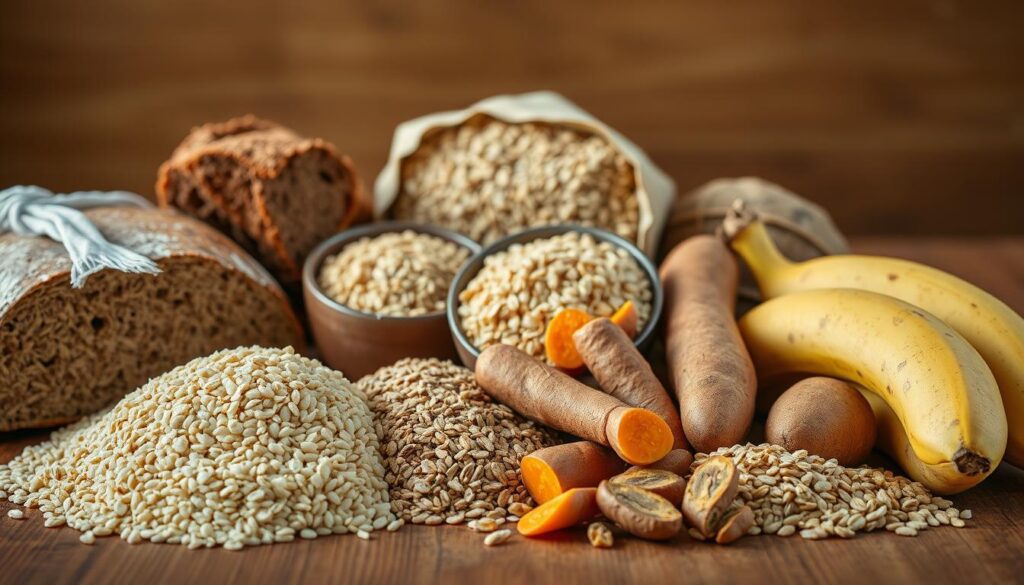
Whole Grains: Brown Rice and Quinoa
Whole grains are great for energy and nutrients. Brown rice has fiber and B vitamins. Quinoa is a complete protein with all essential amino acids. Eat them with lean proteins for balanced meals.
- Brown rice: 1 cup provides 215 calories and 45g carbs
- Quinoa: High magnesium content aids muscle recovery
Fruits: Bananas and Berries
Fruits give natural sugars and antioxidants. Bananas are perfect for quick energy before workouts. Berries like blueberries help reduce inflammation. Eat 1-2 servings a day.
Starchy Vegetables: Potatoes and Squash
Starchy veggies meet energy needs without too much sugar. Potatoes have potassium to prevent cramps. Butternut squash boosts the immune system with vitamin A. Bake or steam to keep nutrients.
Combine carbs with protein for best muscle growth. Adjust carb amounts based on how hard you train. Choose whole foods over processed ones for better energy and nutrients.
The Importance of Healthy Fats in Muscle Building
Healthy fats are often overlooked in a rapid muscle growth diet. But they’re vital for hormone production and recovery. Without the right fats, your muscle-building diet plan could stall progress. Here’s how to harness their power effectively.
“Omega-3s reduce inflammation, aiding faster post-workout recovery.” – Journal of Sports Nutrition
Sources of Unsaturated Fats
Incorporate these fats daily:
- Avocados: Rich in monounsaturated fats for steady energy
- Olive oil: Use in salads or cooking for heart-healthy benefits
- Walnuts: High in ALA omega-3s to support joint health
The Role of Omega-3 Fatty Acids
| Source | Type of Fat | Key Benefits |
|---|---|---|
| Salmon | Omega-3 (EPA/DHA) | Boosts testosterone and reduces muscle soreness |
| Flaxseeds | Omega-3 (ALA) | Supports cell membrane integrity |
Incorporating Nuts and Seeds
Portion control is key. Add:
- 1 oz almonds (160 calories) with meals
- 1 tbsp chia seeds in smoothies
- 2 tbsp olive oil in cooking daily
These fats fuel testosterone production and support recovery without excess calories. Prioritize quality sources to optimize your muscle-building diet plan.
Meal Frequency and Portion Sizes
Eating patterns are key for building muscle, but the debate on 3 meals vs. 6 can be confusing. Studies and client work show that being consistent is more important than following a strict schedule. Here’s how to find the right balance without making things too complicated.
Understanding Meal Timing for Muscle Gain
It’s more important to focus on your total daily calories than how many meals you eat. Research shows that eating 3-6 meals a day works equally well, as long as you meet your protein goals. The idea of an “anabolic window” after workouts is real, but it’s not as strict as you might think. Try to eat within 2 hours after your workout, but don’t stress too much about the exact timing.
Ideal Portion Sizes for Different Meals
Portion sizes should help you reach your goals without any confusion. Here are some simple guidelines to follow:
- Protein: A palm-sized serving of chicken or tofu per meal.
- Carbs: A fistful of rice, oats, or sweet potato.
- Fats: A thumb-sized portion of nuts or avocado.
Here’s a quick guide to adjust your portions based on how active you are:
| Meal Type | Protein | Carbs | Fats |
|---|---|---|---|
| Post-Workout | 30-40g | 50-70g | 10-15g |
| Resting Days | 25-35g | 40-60g | 10-15g |
✅ Discover the Benefits of Moringa!
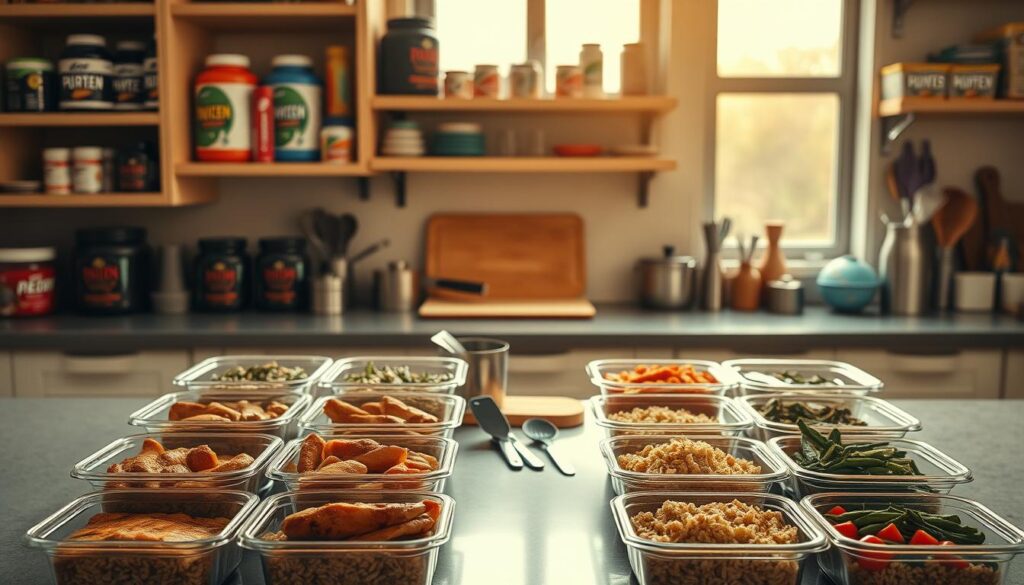
For diet tips for gaining muscle mass, plan your meals in advance with muscle gain meal prep containers. Cook proteins like grilled chicken in bulk and portion them out for easy access. Adjust your portions based on your activity level—eat more before and after workouts, less on rest days. Focus on being consistent rather than perfect, and your body will respond well.
Sample Meal Plans for Muscle Gain
Starting with real meals is key. My muscle-building diet plan examples are here to fuel your workouts and support growth. They’re flexible to fit your tastes.
Sample Breakfast Ideas
Begin with protein-rich breakfasts. Try these:
- Scrambled eggs with spinach + whole-grain toast + avocado (300-400 calories)
- Oatmeal topped with walnuts, banana, and protein powder (250-350 calories)
- Protein smoothie: Greek yogurt, almond milk, frozen berries, and chia seeds (300-350 calories)
Lunch and Dinner Recommendations
These meals offer balanced macros for energy:
- Grilled chicken breast + quinoa + steamed broccoli (500-600 calories)
- Salmon fillet baked with olive oil + sweet potato + asparagus (600-700 calories)
- Black bean tacos with whole-wheat tortillas, salsa, and guacamole (450-550 calories)
My top muscle-building recipes include tofu stir-fry for vegans or turkey chili for meat-lovers.
Healthy Snacks for Muscle Growth
Snack smart to keep energy up:
- Hard-boiled eggs + apple slices
- Protein bar (look for brands like Quest or RXBAR) + almonds
- Plain Greek yogurt + peanut butter + honey
Adjust portions for your calorie needs. My muscle-building diet plan templates work for any diet. Vegetarians can replace chicken with tempeh or lentils.
Supplements to Support Your Diet
Whole foods are key for effective muscle-building nutrition. But, some top muscle-building supplements can help too. Protein powders and creatine support muscle repair and recovery. But, picking the right one can be tricky.
🌟 The Natural Secret to a Healthier Life!
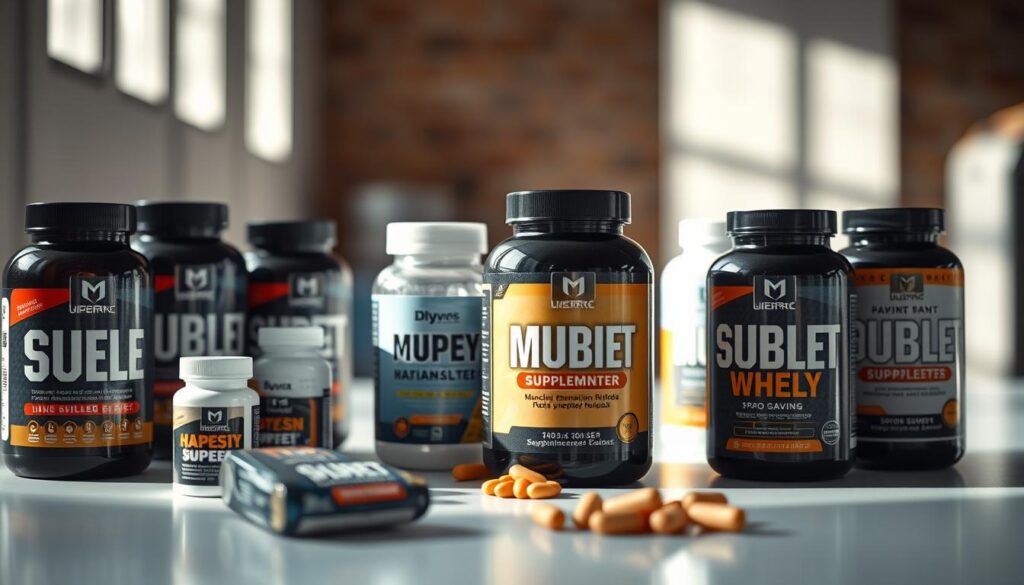
“Creatine monohydrate improves strength and muscle gains in 95% of users, according to a 2023 meta-analysis in the Journal of the International Society of Sports Nutrition.”
Protein Powders: Choosing Your Best Option
- Whey protein: It’s fast-absorbing and full of branched-chain amino acids. Optimum Nutrition’s Gold Standard is a top choice.
- Plant-based blends: Pea and soy proteins are great for vegans. Vega Sport offers complete amino acid profiles.
- Casein: It’s slow-digesting, perfect for overnight muscle support. Look for brands like Transparent Labs for purity.
Creatine: The Science-Backed Staple
Creatine monohydrate is the top choice. Here’s how to use it right:
- Start with 3-5 grams daily. No “loading phase” needed.
- Take with or without meals—consistency matters most.
- Choose reputable brands like NOW Foods for purity and price.
Stick to evidence-based picks. Avoid trendy supplements without research. Always pair supplements with a solid diet and training plan for best results.
Hydration: A Vital Component of Muscle Growth
Hydration is key for effective muscle-building nutrition. It helps move nutrients to muscles and keeps body temperature stable during exercise. Without enough water, even the best diet won’t help you gain muscle quickly.
How Much Water Do You Need?
Begin with 0.5-1 ounce of water for every pound of your weight each day. For every hour of hard training, add 16-20 ounces. So, a 160-pound person should drink 80-160 ounces daily, plus more during exercise.
Coconut water or electrolyte tablets can help during long workouts.
The Impact of Dehydration on Performance
- Strength dips by 2-3% with just 2% fluid loss
- Recovery slows due to impaired nutrient delivery
- Endurance declines as blood volume drops
Watch for headaches, dizziness, or dark urine. These are signs you need more water. Always carry a water bottle and keep track of how much you drink.
Overcoming Common Dietary Challenges
Building muscle isn’t just about eating right—it’s about staying consistent when life gets hectic. These diet tips for gaining muscle mass help you navigate cravings, budget limits, and social situations without losing momentum.
Managing Cravings and Junk Food
Cravings don’t have to break your progress. Swap empty snacks for best foods for muscle gain like hard-boiled eggs or Greek yogurt with berries. Pair protein with fiber to stay full longer:
- Keep roasted chickpeas or beef jerky in your bag for emergencies
- Swap chips for apple slices with peanut butter or cottage cheese
- Allow one small treat weekly but prioritize nutrient-dense options first
“Focus on 80% nutrient-rich meals and save 20% for flexibility,” says registered dietitian Sarah Thompson.
Eating on a Budget
Maximize your food budget with strategic shopping. Prioritize affordable proteins like eggs, canned tuna, and chicken thighs. Try these tips:
- Buy store-brand oats, beans, and frozen veggies for bulk savings
- Use meatless meals twice weekly with lentils or tofu
- Plan meals around sales and freeze leftovers
When dining out, order grilled protein (chicken, fish) with steamed veggies. Pack snacks for travel to avoid high-calorie airport options. Small adjustments keep you on track without breaking the bank.
Tracking Progress and Making Adjustments
It’s important to watch your diet and body changes to build muscle. Without tracking, it’s hard to see if your plan works. Use tools like food journals or apps to log meals and check your muscle gain meal prep strategy.
Monitoring Your Food Intake
Begin by recording every meal. Apps like MyFitnessPal make tracking calories and macros easy. Cooking meals in batches, especially those high in protein, helps avoid mistakes. Also, note how your body reacts to different foods and amounts.
Adjusting Your Diet for Optimal Growth
Stagnation means it’s time to change your plan. Here’s how:
- Weigh yourself weekly to spot plateaus
- Increase protein by 10g weekly if strength gains slow
- Adjust carb intake based on workout intensity
If you’re gaining fat, cut your calorie surplus by 100-200 kcal. If strength plateaus, up your protein to 1.6-2g per pound of body weight. Remember, your high protein diet for muscle growth can change.
“Progress isn’t linear. Adaptation is part of the process.”
Check your progress every 2-3 weeks. Small changes can lead to big results. Stay consistent but be ready to adjust when needed.
Conclusion: Making Nutrition Work for You
This guide is designed to help you create a diet that supports rapid muscle growth. The strategies I’ve shared are tools to help you. But, your success depends on making them fit your lifestyle.
A good plan mixes science with what you like, so you can stick to it. This balance is key to long-term success.
Building a Sustainable Diet
Choose foods you enjoy to stay motivated. Try recipes like grilled chicken and quinoa bowls or salmon with roasted veggies. This keeps things interesting and helps you stay on track.
Be flexible with portions and timing. Avoid strict rules to prevent burnout. This way, you can enjoy your diet without feeling trapped.
Embracing a Lifestyle Change for Muscle Gain
Focus on being consistent, not perfect. Eat whole foods and drink plenty of water every day. Try new recipes to keep your meals exciting.
Track your progress weekly, not daily. This helps you stay motivated. Celebrate small victories along the way. Many people have found success by being patient and adaptable.
With the right mindset, you can build muscle and improve your health through diet.
FAQ
What constitutes a high-protein diet for muscle growth?
What are some effective muscle-building recipes?
Can I gain muscle mass quickly without supplements?
What are the best foods for muscle gain?
How often should I eat to maximize muscle gain?
What are some diet tips for gaining muscle mass?
How can I prepare meals for muscle gain?
What are some top muscle-building supplements to consider?
How important is hydration for muscle growth?
Did you like this article? See also: Discover Foods that Help Control Blood Pressure

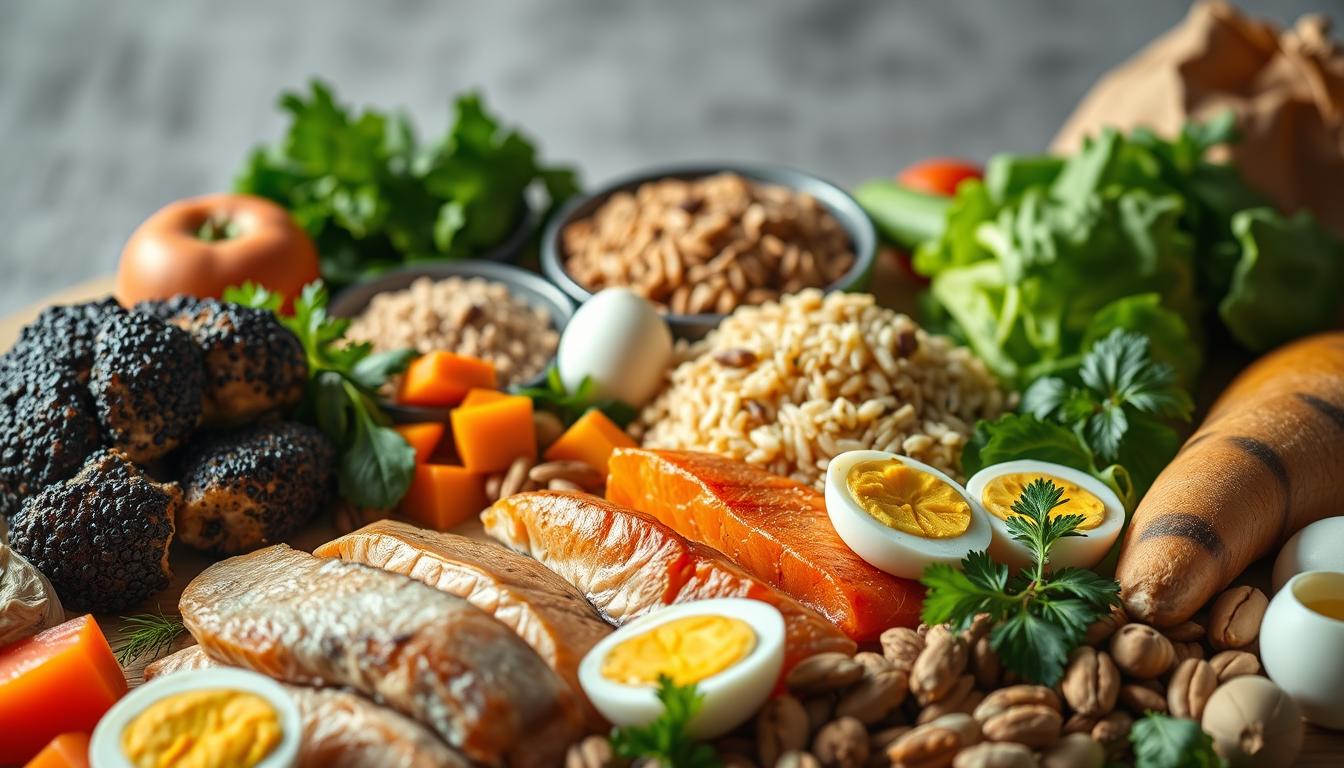
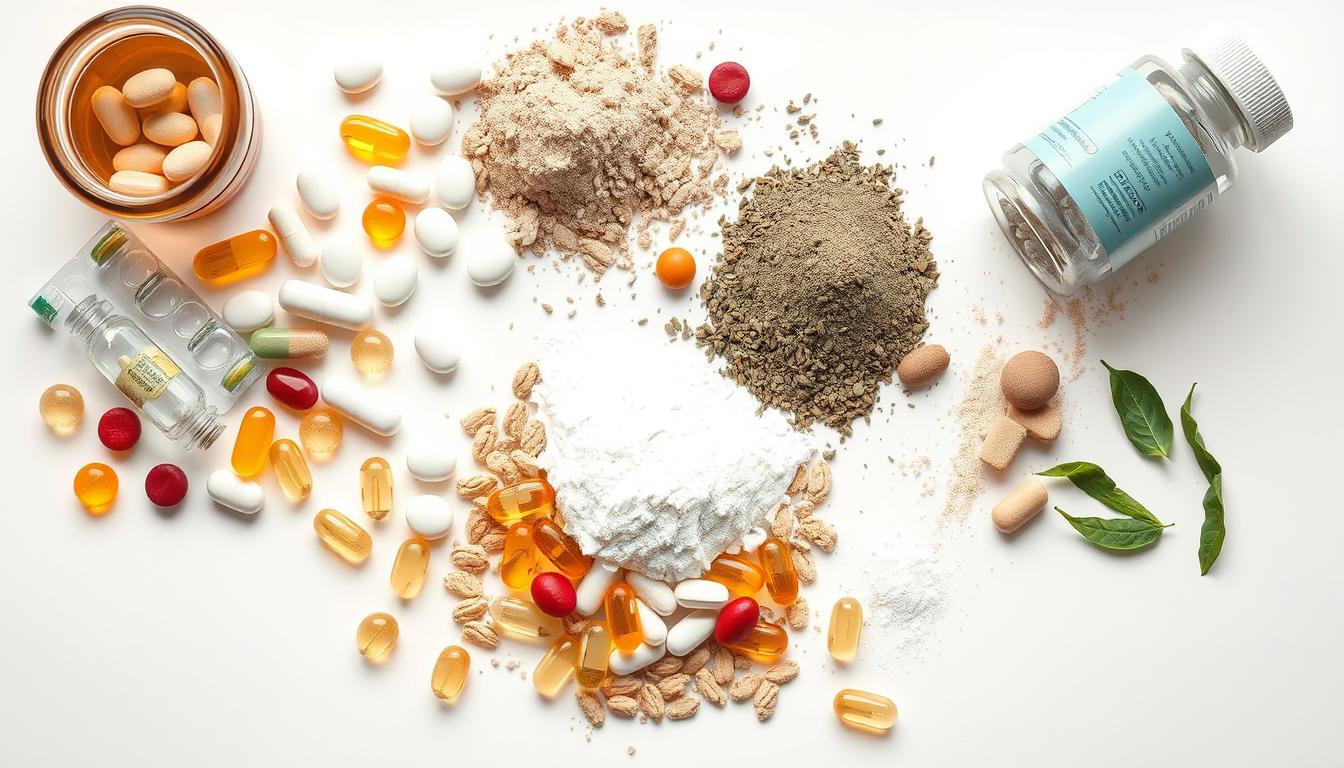
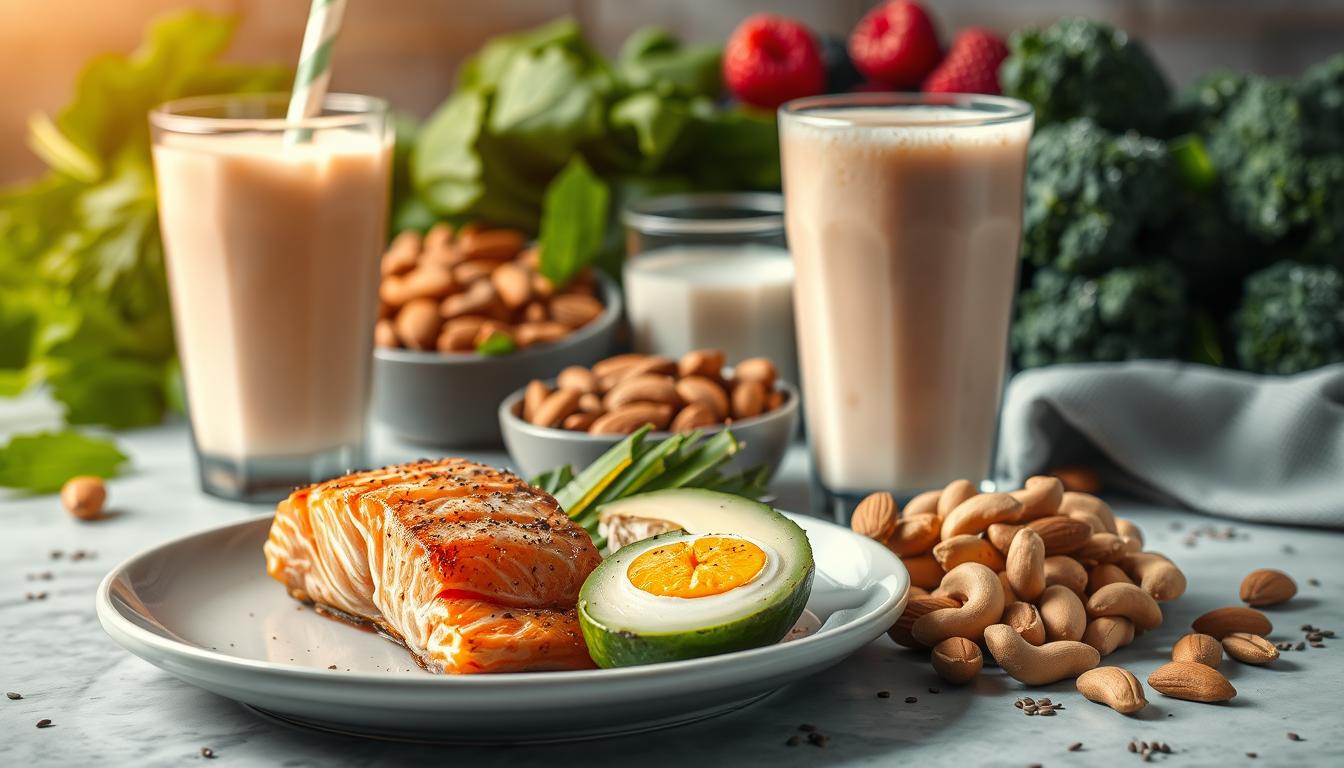
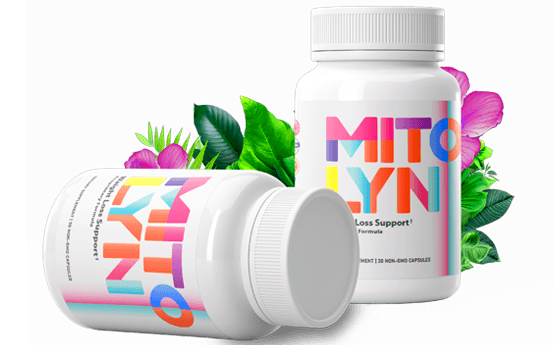

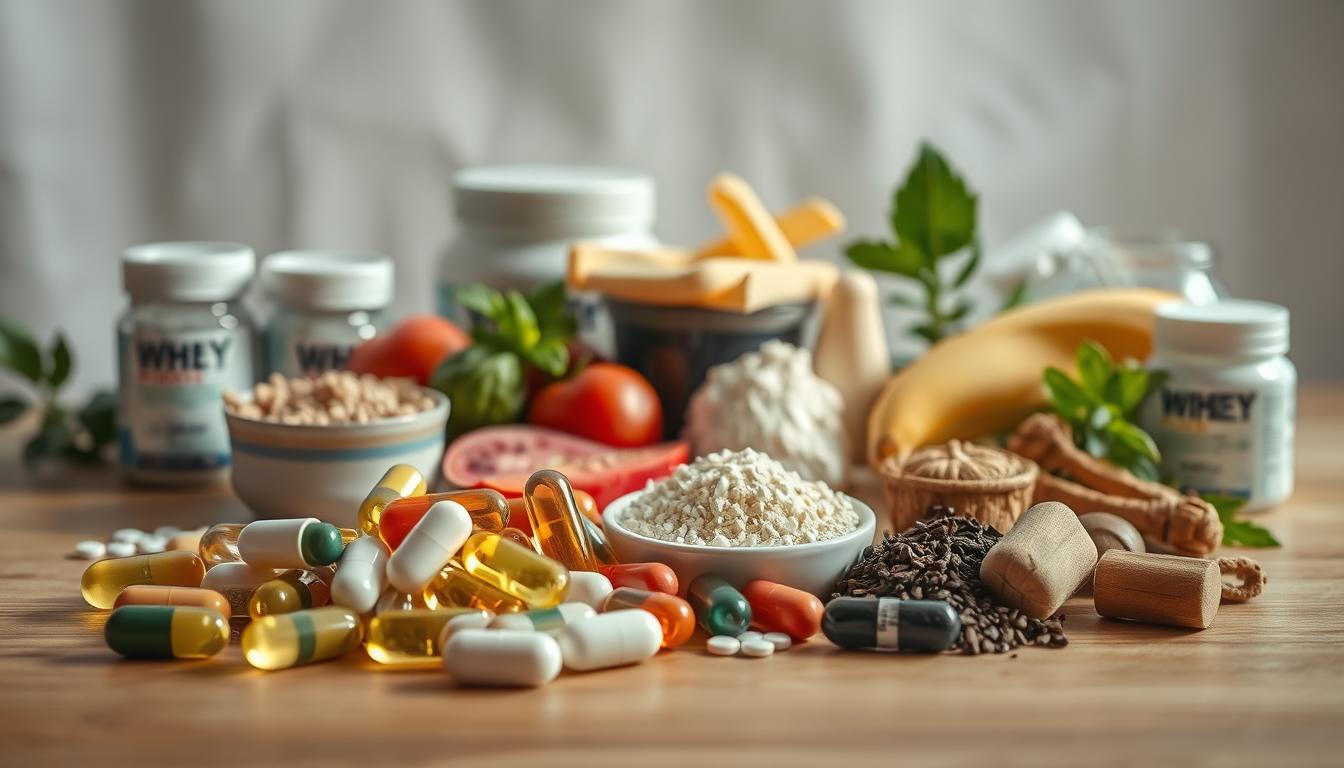
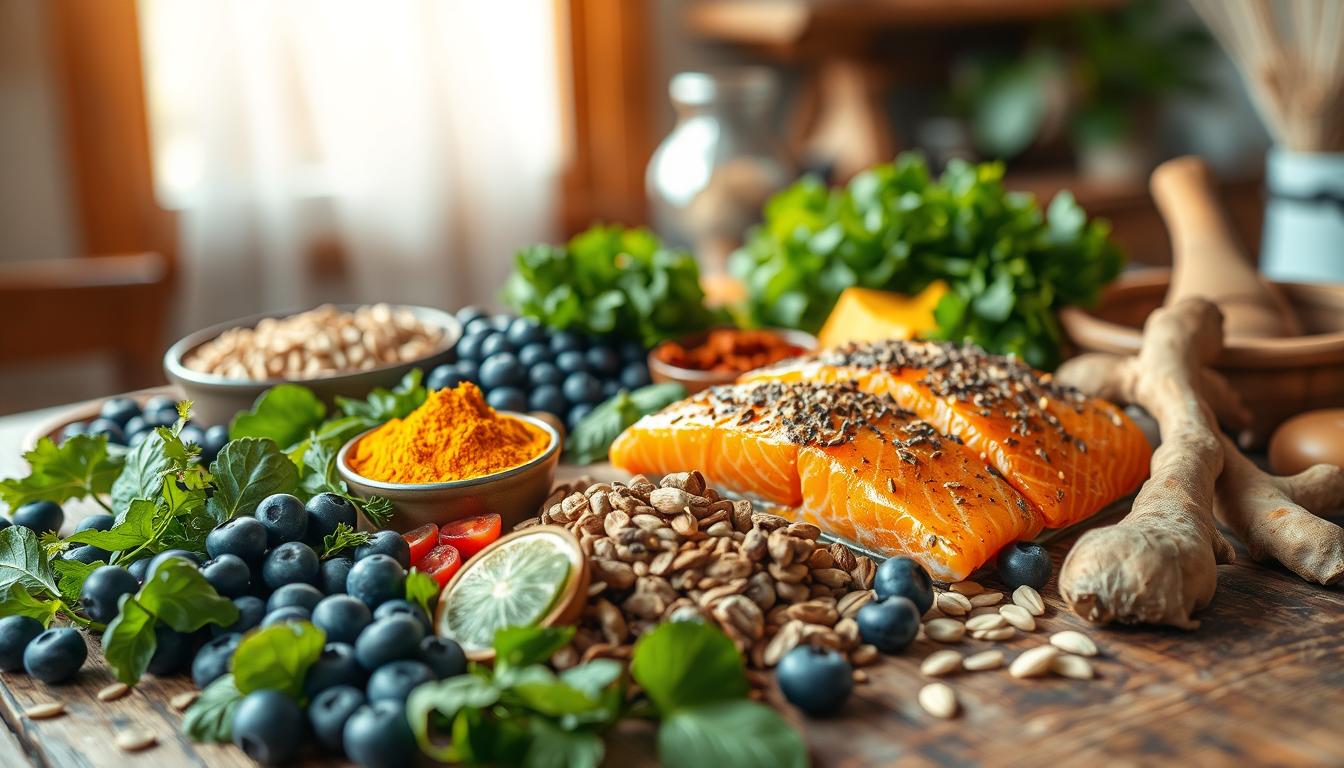
Comment on “The Best Diet to Gain Muscle Mass Fast”